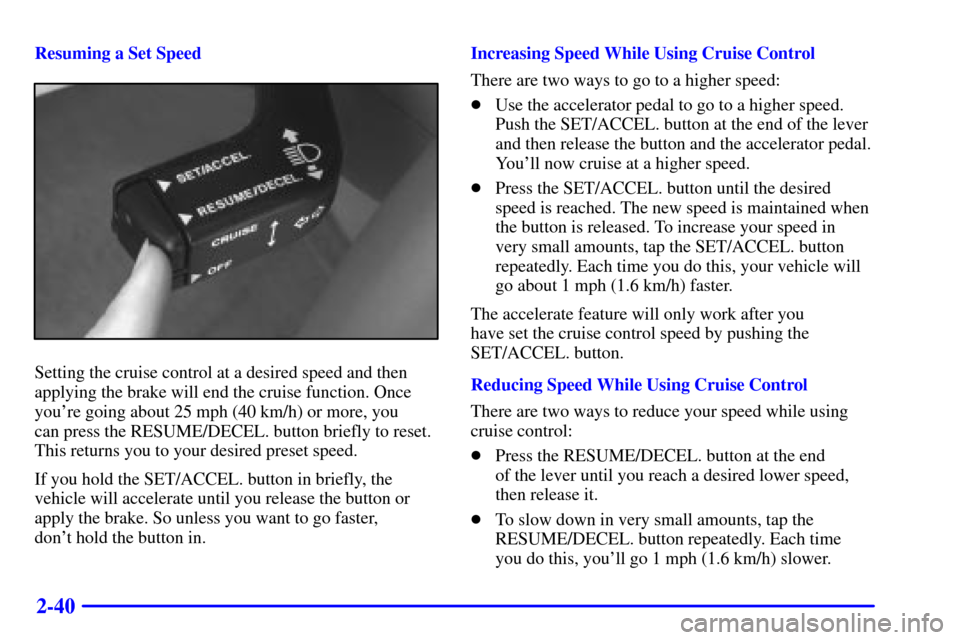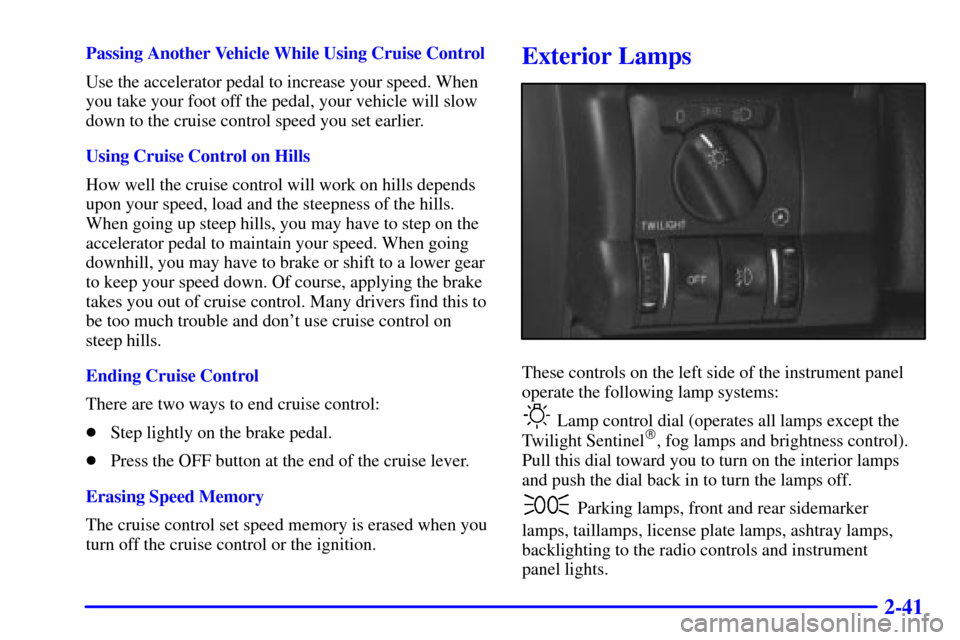Page 4 of 321
ii
Table of Contents
Keys and Door Locks
Remote Keyless Entry (RKE) System
Trunk Release
Automatic Transmission
Windows
Tilt Wheel
Turn Signal/Multifunction Lever
Windshield Wipers
Cruise ControlInterior and Exterior Lamps
Mirrors
Storage Compartments
Convenience Net
Accessory Power Outlet
OnStar® System (If Equipped)
Sunroof (Option)
HomeLink® Transmitter (Option)
Instrument Panel, Warning Lights and Gages Seats and Seat Controls
Safety BeltsAir Bag Systems
Child Restraints
Section
1
Section
2
Seats and Restraint Systems
Features and Controls
Page 103 of 321
2-38 Cruise Control
With cruise control, you can maintain a speed of about
25 mph (40 km/h) or more without keeping your
foot on the accelerator. This can help on long trips.
Cruise control does not work at speeds below about
25 mph (40 km/h).
Cruise control shuts off when you apply the brakes.
CAUTION:
�Cruise control can be dangerous where
you can't drive safely at a steady speed.
So, don't use your cruise control on
winding roads or in heavy traffic.
�Cruise control can be dangerous on
slippery roads. On such roads, fast changes
in tire traction can cause needless wheel
spinning, and you could lose control.
Don't use cruise control on slippery roads.
If your vehicle is in cruise control when the traction
control begins to limit wheel spin, the cruise control
will automatically disengage. (See ªTraction Control
Systemº in the Index.) When road conditions allow you
to safely use it again, you may turn the cruise control
back on.
Page 104 of 321
2-39
Setting Cruise Control
CAUTION:
If you leave your cruise control switch on when
you're not using cruise, you might hit a button
and go into cruise when you don't want to. You
could be startled and even lose control. Keep the
cruise control switch off until you want to use
cruise control.
1. Accelerate to the speed you want.2. Press the SET/ACCEL button at the end of the lever
and release it.
3. Remove your foot from the accelerator pedal.
Page 105 of 321

2-40
Resuming a Set Speed
Setting the cruise control at a desired speed and then
applying the brake will end the cruise function. Once
you're going about 25 mph (40 km/h) or more, you
can press the RESUME/DECEL. button briefly to reset.
This returns you to your desired preset speed.
If you hold the SET/ACCEL. button in briefly, the
vehicle will accelerate until you release the button or
apply the brake. So unless you want to go faster,
don't hold the button in.Increasing Speed While Using Cruise Control
There are two ways to go to a higher speed:
�Use the accelerator pedal to go to a higher speed.
Push the SET/ACCEL. button at the end of the lever
and then release the button and the accelerator pedal.
You'll now cruise at a higher speed.
�Press the SET/ACCEL. button until the desired
speed is reached. The new speed is maintained when
the button is released. To increase your speed in
very small amounts, tap the SET/ACCEL. button
repeatedly. Each time you do this, your vehicle will
go about 1 mph (1.6 km/h) faster.
The accelerate feature will only work after you
have set the cruise control speed by pushing the
SET/ACCEL. button.
Reducing Speed While Using Cruise Control
There are two ways to reduce your speed while using
cruise control:
�Press the RESUME/DECEL. button at the end
of the lever until you reach a desired lower speed,
then release it.
�To slow down in very small amounts, tap the
RESUME/DECEL. button repeatedly. Each time
you do this, you'll go 1 mph (1.6 km/h) slower.
Page 106 of 321

2-41
Passing Another Vehicle While Using Cruise Control
Use the accelerator pedal to increase your speed. When
you take your foot off the pedal, your vehicle will slow
down to the cruise control speed you set earlier.
Using Cruise Control on Hills
How well the cruise control will work on hills depends
upon your speed, load and the steepness of the hills.
When going up steep hills, you may have to step on the
accelerator pedal to maintain your speed. When going
downhill, you may have to brake or shift to a lower gear
to keep your speed down. Of course, applying the brake
takes you out of cruise control. Many drivers find this to
be too much trouble and don't use cruise control on
steep hills.
Ending Cruise Control
There are two ways to end cruise control:
�Step lightly on the brake pedal.
�Press the OFF button at the end of the cruise lever.
Erasing Speed Memory
The cruise control set speed memory is erased when you
turn off the cruise control or the ignition.Exterior Lamps
These controls on the left side of the instrument panel
operate the following lamp systems:
Lamp control dial (operates all lamps except the
Twilight Sentinel�, fog lamps and brightness control).
Pull this dial toward you to turn on the interior lamps
and push the dial back in to turn the lamps off.
Parking lamps, front and rear sidemarker
lamps, taillamps, license plate lamps, ashtray lamps,
backlighting to the radio controls and instrument
panel lights.
Page 141 of 321
2-76
NOTICE:
Damage to your engine from neglected oil
problems can be costly and is not covered by
your warranty.
Check Oil Light
This light will come on for
a few seconds when the
ignition is turned on. If the
light doesn't come on, have
it repaired.
If the light comes on while starting and stays on for about
one minute or comes on while driving, the engine oil level
should be checked. Prior to checking the oil level, be sure
your vehicle has been shut off for several minutes and is
on a level surface. Check the oil level and bring it to the
proper level. See ªEngine Oilº in the Index.
Brake To Shift Light
This light will come on to
remind you that you must
press the brake pedal to
shift out of PARK (P).
Cruise Control Light
This light comes on
whenever you set your
vehicle's cruise control.
Page 302 of 321
6-58
Instrument Panel Fuse Block (Driver's Side)
The fuse block is located below the steering wheel on
the driver's side. Using a screwdriver, loosen the two
trim fasteners under the trim panel and pull the trim
panel away from the instrument panel to access.
Fuse Usage
1 RH and LH Front Side Door Window
Regulator Motor, LH Front Side Door
Window Switch
2 Stoplamp Switch, Cruise Control
Release Switch
3 Automatic Transmission Range Switch,
Automatic Transmission Control Indicator,
Power Steering Control Module, Hazard
Warning Switch, Automatic Transmission
Winter Mode Switch, Transmission
Control Module (TCM)
Page 303 of 321

6-59
Fuse Usage
4 RH and LH Rear Seat Cushion Heater
Relay, Rear Sunshade Motor, Accessory
Power Outlet
5 Transmission Control Module
6 Radio Speaker Amplifier
7 RH and LH Rear Side Door Window
Regulator Motor
8 Headlamp Switch, Turn Signal
Switch, Horn Relay, CD Changer,
Multifunction Relay
9 Windshield Wiper Motor and Relay,
Windshield Wiper and Windshield
Washer Switch
10 Body Control Module (BCM), Heater
Water Auxiliary Pump, Fan Control
Relays, Auxiliary Water Pump Relay
11 Heater and A/C Control, RH and LH
Outside Rearview Mirrors
12 Hazard Warning Switch, Instrument
Cluster, Data Link Connector (DLC),
Stoplamp Switch, Gage Cluster, Heater
and A/C Control.Fuse Usage
13 Remote Control Outside Rearview Mirror
Switch, A/C Compressor Relay, Coolant
Fan Test Connector, A/C Load Switch
14 Cellular Telephone, RH and
LH Windshield Washer Nozzles,
Driver and Passenger Heated Seat Switch,
Heater and A/C Control, Heated Outside
Rearview Mirror and Rear Window
Defogger Relay
15 Rear Suspension Leveling Air Compressor
Relay, Instrument Cluster, Gage Cluster,
Cruise Control Switch, Headlamp Switch,
Multifunction Relay, Passenger and
Driver Heated Seat Relay, BCM, Sunroof
Actuator, Automatic Level Control Sensor,
RH and LH Heated Rear Seat Switch, RH
and LH Heated Rear Seat Cushion Relay,
Driver Seat Adjuster Memory Module,
LH Front Side Door Window Switch,
Inside Rearview Mirror
16 Cigarette Lighter (Front and Console)
17 Horn #1 and #2
18 Fuel Pump